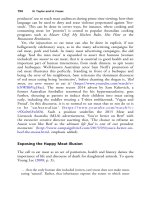The palgrave international handbook of a 214
Bạn đang xem bản rút gọn của tài liệu. Xem và tải ngay bản đầy đủ của tài liệu tại đây (26.65 KB, 1 trang )
Collecting Wildlife
209
obsessive and the pursuit of their hobby can cost them thousands of pounds
each year. Egg collectors have been known to travel all over Europe in pursuit
of eggs and some individuals involved in (illegal) taxidermy have been found
in possession of species taken globally (Huffington Post 2012; National
Crime Agency 2015). There is some similarity with other forms of offender
who obsessively collect banned rare or expensive items such as rare books,
pornography and stolen paintings (Burk 2001; Taylor and Quayle 2003, and
discussed below). The desire not just to obtain items but also to catalogue
and categorise them is a factor in the offending behaviour. Examination of
case records and prosecution evidence as well as the author’s past knowledge
of casework indicates that egg collectors are exclusively male as no records
could be found of any female egg collectors in the UK.1 Hobby criminals
thus typify specific male activity and while issues of masculinities should be
considered in examining hobby crimes these crimes are not primarily of the
distinctly masculine type identified in Model C but instead are often driven
by obsessive-compulsive needs as discussed below. Recidivism is a particular
issue in animal collecting offences where investigators regularly encounter the
same repeat offenders and evidence exists that even those offenders who are
repeatedly caught convicted and fined are not deterred (Nurse 2013a).
English egg collector Colin Watson for example was caught and convicted
six times; had paid fines of thousands of pounds and had his collection of
eggs confiscated. Despite the fact that he was known to police and staff
involved in protecting rare birds’ nests he was suspected of still being
involved in an egg collecting expedition when he fell to his death in May
2006 (Wainwright 2006).
Collecting as Prohibited Activity
Much animal collecting activity is prohibited by law, partially reflecting a
species justice approach to protecting nonhuman animals from human
persecution (Benton 1998; White 2008). Within the UK, for example,
possession of wild birds’ eggs is an offence of strict liability by virtue of
provisions within the Wildlife and Countryside Act 1981 making it an
offence merely to possess wild birds’ eggs. Possessors of wild birds’ eggs are
obliged to show, on a balance of probabilities, that their possession is lawful;
1
Nurse (2013a, 2011) conducted analysis of RSPB statistics, annual reports, case reports and newspaper
reports on egg collecting cases.









